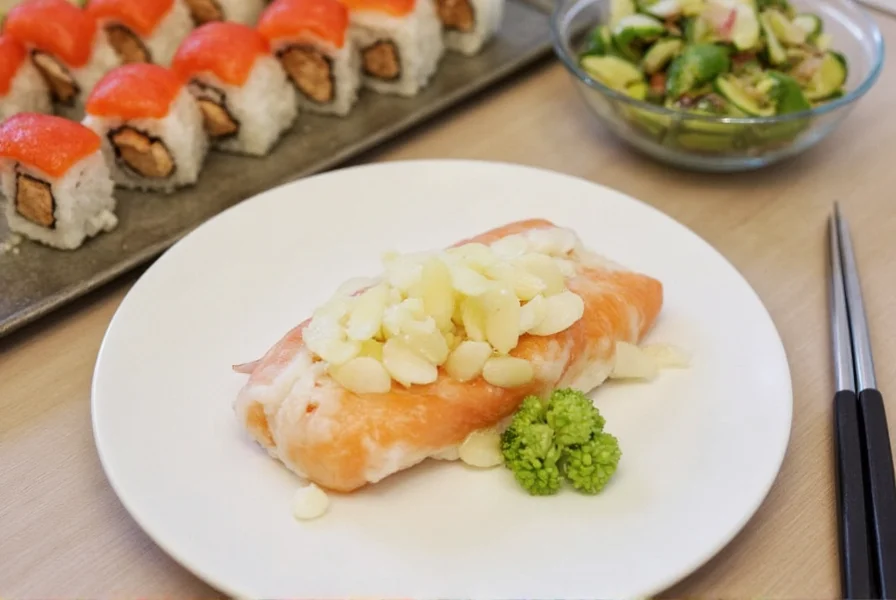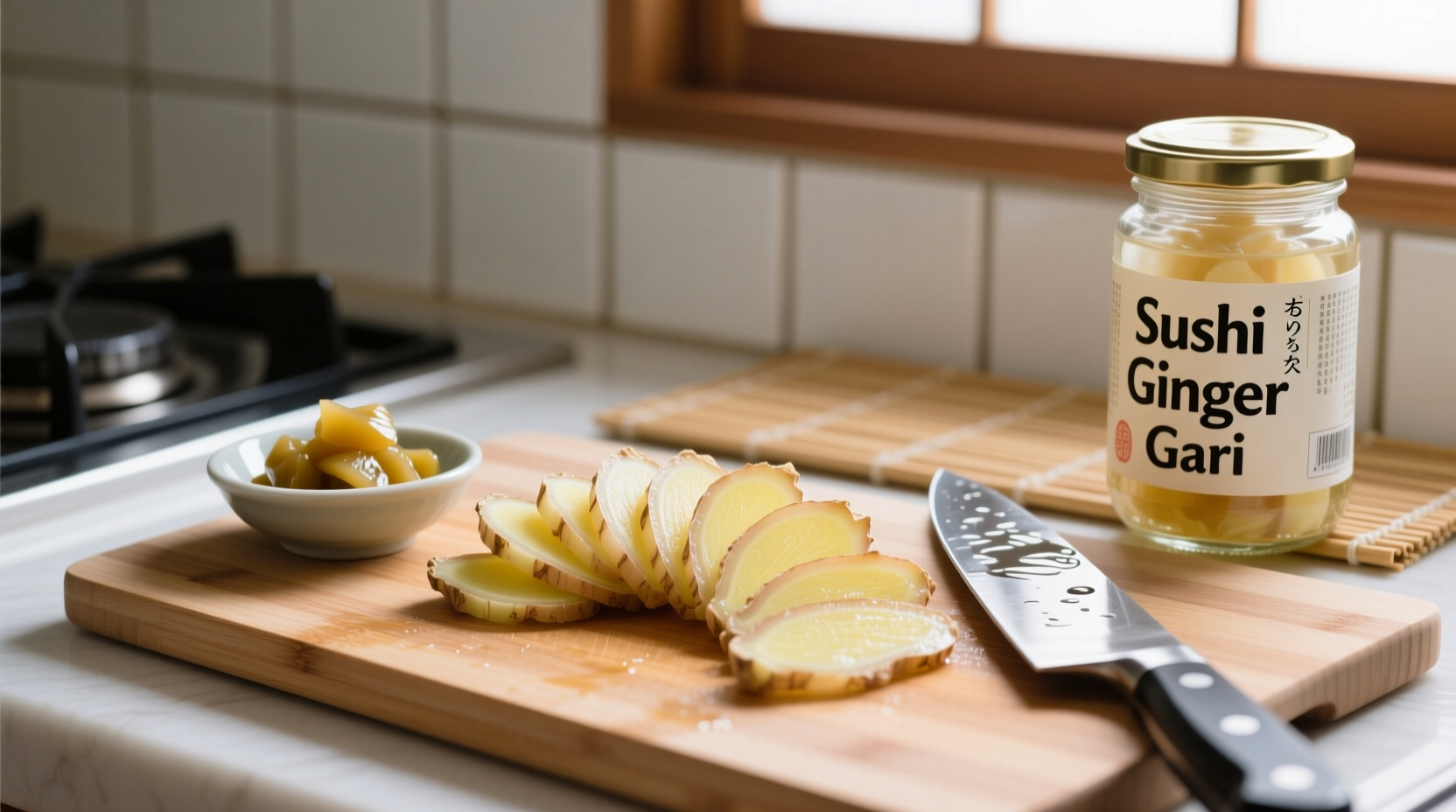The Sushi Ginger Confusion You Didn’t Know You Had
Most Western sushi restaurants serve artificially pink “gari”—a misrepresentation of Japanese culinary tradition. This creates a universal pain point: home cooks following online “how to make sushi ginger” guides end up with neon-pink results that taste nothing like authentic Japanese condiments. Why? Because true sushi ginger for donburi dishes is beni shōga, naturally red from umeboshi plums, not vinegar-dyed ginger. The confusion stems from cultural export errors: when Japanese cuisine spread globally, gari (a separate sushi palate cleanser) was mistakenly labeled “sushi ginger” in the West.

Beni Shōga vs. Gari: Why the Color Matters
Understanding this distinction reshapes your entire approach. Beni shōga (紅生姜) is a red ginger pickle served as a condiment with rice bowls (donburi). Gari is a thinly sliced, sweetened ginger eaten between sushi pieces to cleanse the palate. The critical difference? Beni shōga’s red hue comes exclusively from anthocyanins in umeboshi plums—never artificial dyes. This isn’t just aesthetic; umeboshi adds tart complexity that balances rich dishes like katsudon. Western recipes omitting umeboshi produce inauthentic, one-dimensional results.
| Feature | Authentic Beni Shōga | Western "Gari" |
|---|---|---|
| Color source | Natural anthocyanins from umeboshi | Artificial dyes (e.g., cochineal, beet juice) |
| Primary use | Donburi rice bowls (gyūdon, tendon) | Served with nigiri/sushi |
| Texture | Finely julienned (2mm x 1.5cm) | Thinly sliced |
| Prep time | 10+ days for color development | Ready in hours |
| Flavor profile | Tangy, complex, umami-rich | Sweet, one-dimensional |
Why Umeboshi is Non-Negotiable
Professional Japanese chefs universally reject dye substitutes. As verified by The Muddled Pantry, umeboshi provides three irreplaceable elements:
- Natural red pigment through anthocyanins (pH-dependent color change)
- Acidic balance that preserves ginger without overpowering vinegar
- Umami depth from lactic fermentation during plum pickling
Substitutes like beet juice or vinegar+salt fail because they lack umeboshi’s enzymatic complexity. One Tokyo chef notes: “Umeboshi is the soul of beni shōga—without it, you’re making ginger candy.”
Step-by-Step Authentic Beni Shōga Recipe
Based on verified Japanese culinary practice, this method requires patience but guarantees authenticity. Never skip the 10-day wait—color development is enzymatic, not instantaneous.

Ingredients (Yields 200g)
- 75-100g fresh ginger (young, firm rhizomes)
- 5-6 umeboshi plums (with 2 tbsp brine)
- 150ml rice vinegar
- 2 1/2 tbsp caster sugar
Method
- Heat vinegar and sugar until dissolved (do not boil).
- Add umeboshi with brine; simmer 1 minute. Gently crush plums with a spoon.
- Cool liquid completely to room temperature.
- Peel ginger, julienne into 2mm x 1.5cm strips (thicker pieces won’t absorb color).
- Combine ginger and liquid in sterilized jar. Seal tightly.
- Refrigerate 10-14 days. Ginger turns deep red as anthocyanins migrate.
When to Use (and Avoid) Homemade Beni Shōga
Understanding application boundaries prevents culinary missteps. This isn’t a universal substitute:
| Scenario | Use Beni Shōga | Avoid Beni Shōga |
|---|---|---|
| Dish type | Gyūdon, katsudon, tendon | Nigiri/sushi platters |
| Flavor pairing | Rich, fatty meats (beef, pork) | Delicate fish (sea bass, flounder) |
| Storage condition | Refrigerated (<4°C) for 3 months | Room temperature or >6 months |
| Ingredient quality | Using authentic umeboshi | Substituting with vinegar+dye |
Avoiding Costly Mistakes: Quality Checks
Amateur attempts often fail due to three market traps. Verify authenticity with these methods:
- Color test: Authentic beni shōga shifts from pale yellow to deep red over 10 days. If it’s pink immediately, artificial dye was used.
- Umeboshi check: Plums must be whole with pits intact. Pre-crushed umeboshi paste lacks enzymatic activity for color development.
- Texture warning: Avoid recipes using grated ginger—only hand-julienned strips retain structure during pickling.
Major supermarkets often sell “Japanese ginger” with cochineal dye. True beni shōga lists “ume plum extract” as the sole coloring agent per Japan’s Ministry of Health guidelines.
Final Recommendation: The Only Authentic Path
For genuine Japanese flavor, never compromise on umeboshi. While Western “pink ginger” recipes promise speed, they erase cultural nuance. Source umeboshi from Japanese grocers (look for “shiozuke” style) or trusted online retailers like Umami Mart. Remember: beni shōga’s purpose is to cut through rich donburi dishes—not to “go with sushi.” If serving sushi, use traditional gari (made separately with young ginger and sugar).
Everything You Need to Know
Authentic beni shōga requires 10-14 days of refrigeration for anthocyanins from umeboshi to develop the red color. If using artificial dyes (common in Western recipes), color appears immediately but isn’t authentic. Verify you used whole umeboshi plums—not substitutes like beet juice. As confirmed by The Muddled Pantry, skipping the wait time yields pale, inauthentic results.
No—umeboshi is irreplaceable for authentic beni shōga. Substitutes like vinegar+salt or beet juice create artificial pink “gari,” not true Japanese condiment. Umeboshi provides natural anthocyanins for red color, enzymatic complexity, and umami depth absent in alternatives. Professional Japanese chefs universally reject workarounds, as documented in culinary resources like The Muddled Pantry. For sushi pairing, use traditional gari instead.
Properly stored in a sterilized jar at <4°C, authentic beni shōga lasts 3 months. Discard if liquid becomes cloudy or ginger softens—signs of spoilage. Unlike Western “pink ginger” with preservatives, natural beni shōga relies on umeboshi’s acidity for preservation. Always use clean utensils to prevent contamination, per Japan’s food safety standards.
Authentic beni shōga offers digestive benefits from raw ginger and probiotics in umeboshi, but it’s high in sodium (from plum brine). A 10g serving contains ~120mg sodium—safe for most adults but limit if on sodium-restricted diets. Avoid Western versions with artificial dyes like cochineal, which may trigger allergies. As per NIH research, natural ginger compounds aid digestion, but beni shōga’s primary role is culinary, not medicinal.
No—beni shōga is designed for donburi rice bowls (e.g., gyūdon), not sushi. Its robust flavor overpowers delicate fish. For sushi, use traditional gari: thinly slice young ginger, soak in 1:1 rice vinegar/sugar for 3-5 hours. Authentic Japanese restaurants never serve beni shōga with sushi—this confusion stems from Western mislabeling, as clarified by culinary experts like The Muddled Pantry.










 浙公网安备
33010002000092号
浙公网安备
33010002000092号 浙B2-20120091-4
浙B2-20120091-4